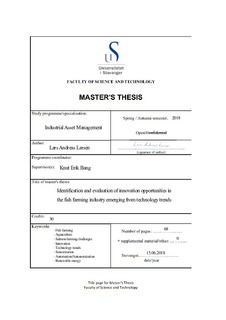| dc.description.abstract | There are 7.6 billion people on this planet today, and it is predicted that the world’s population will exceed 9 billion people by 2050, which will lead to a significant increase in the worldwide demand for food. With this immense growth in population, it is estimated that the world must increase the production of meat and animal products by 40% over the next 15 years. When oceans cover more than two thirds of the world’s surface, and only 2% of the food energy for human consumption comes from the sea, the increasing food demand will cause the fish farming industry to play a major part in feeding future generations.
In addition to the fact that the fish farming industry need to produce more fish in the future, the industry is required to do so using less resources and with a minimal environmental footprint. This increasing demand will threaten the sustainability of fish farming and cause the industry to be even more exposed to the already major challenges associated with salmon lice and environmental pollutions.
To achieve growth and maintain sustainability, the industry need to invest in technology development to improve today’s solutions in line with evolving challenges and the expected increase of production demand. To comprehend with these emerging biological, economic and social challenges, the fish farming industry in the future is assumed to be moved more out to the sea, to maintain an ethically sound, productive and environmental friendly production of salmon. When fish farming will be placed offshore and on remote locations, the fish farms will also increase in size and complexity, as well as being more exposed to harsher environment. It is therefore important for the industry to adapt to the emerging technology trends and aspires to more innovative and sophisticated technology that will improve farming management and create farming solutions that provide sufficient knowledge and information to monitor and control the biological process.
The innovative opportunities for a future sustainable fish farming industry are mainly derived from emerging technology trends such as renewable energy and energy storage, sensorization, connectivity (IoT) and autonomization. This thesis investigates how these technology trends can impact fish farming, and identifies various innovative opportunities derived from these trends. The innovative opportunities and solutions identified are evaluated in terms of how they can improve current solutions and improve fish farming in relation to monitoring and control of biological processes, net pen and surrounding environment, feeding processes, lice infestations, as well as their potential for realization of more automated, unmanned and remotely operated farming systems and operations.
After reviewing the possibilities for energy storage and offshore power generation, it has been found that there is a high readiness level for off-grid energy solutions for fish farming. The recent development in offshore wind power, solar power and wave power in combination with Li-Ion battery storage enables the possibility for self-sufficient energy systems that can power a full-size farm site, while eliminating CO2 emissions and the excessive costs from diesel generator systems.
The development in sensorization, connectivity and digitalization has increased the level of computational capacity which enables algorithms to collect and interpret data recorded by sensors and transform this into useful information. With advanced algorithms, robotic technology and artificial intelligence this information can without human intervention be interpreted and acted upon automatically. This technology is well established in other industries, and if implemented in fish farming, it can contribute to move commercial fish farming from a current state of manual monitoring and operations and experience-based decision-making towards a more automatic/autonomic and knowledge-based farming regime. The Precision Fish Farming (PFF) concept breaks down the operational phases in fish farming and types of sensors that can be implemented, showing how the utilization of sensorization and connectivity is the key technology trend in realization of more automated, unmanned and remotely operated farming solutions and processes.
Opportunities in autonomization are investigated, with an evaluation of several ongoing and already implemented projects that utilizes robotics technology for improved lice control and lice removal, as well as specific possibilities for autonomous operations as net cleaning systems, feeding systems and daily operations as cage inspection, maintenance and repair. The already implemented Stingray-system uses laser technology and advanced software and camera vision, to identify and shoot sea lice that are attached to salmon, without causing any harm to the fish. The Stingray technology has also the possibility for automatic and optical sea lice counting and biomass measurement. Other patent pending project research on enabling unmanned fish farms and land-based control centres, by utilizing an unmanned surface vehicle (USV) to carry a ROV and drone between sea cages to perform daily operations and inspections.
Together, all these innovative opportunities that emerge from the technological trends will in the near future contribute to move fish farming more out to sea, as well as contributing to cope with the various challenges that will evolve in line with the growing industry. | nb_NO |

